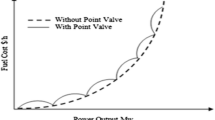Abstract
This paper presents an efficient and reliable genetic algorithm (GA) based particle swarm optimization (PSO) technique (hybrid GAPSO) for solving the economic dispatch (ED) problem in power systems. The non-linear characteristics of the generators, such as prohibited operating zones, ramp rate limits and non-smooth cost functions of the practical generator operation are considered. The proposed hybrid algorithm is demonstrated for three different systems and the performance is compared with the GA and PSO in terms of solution quality and computation efficiency. Comparison of results proved that the proposed algorithm can obtain higher quality solutions efficiently in ED problems. A comprehensive software package is developed using MATLAB.
Similar content being viewed by others
References
Chen, P.H., Chang, H.C., 1995. Large scale economic dispatch by genetic algorithm. IEEE Trans. on Power Syst., 10(4):1919–1926. [doi:10.1109/59.476058]
Fung, C.C., Chow, S.Y., Wong, K.P., 2000. Solving the Economic Dispatch Problem with an Integrated Parallel Genetic Algorithm. Proc. Int. Conf. on Power System Technology, p.1257–1262.
Gaing, Z.L., 2003. Particle swarm optimization to solving the economic dispatch considering the generator constraints. IEEE Trans. on Power Syst., 18(3):1187–1195. [doi:10.1109/TPWRS.2003.814889]
Huang, C.M., Huang, C.J., Wang, M.L., 2005. A particle swarm optimization to identify the ARMAX model for short term load forecasting. IEEE Trans. on Power Syst., 20(2):1126–1133. [doi:10.1109/TPWRS.2005.846106]
Kennedy, J., Eberhart, R., 1995. Particle Swarm Optimization. Proc. IEEE Int. Conf. on Neural Networks, 4:1942–1948. [doi:10.1109/ICNN.1995.488968]
Lee, F.N., Breipohl, A.M., 1993. Reserve constrained economic dispatch with prohibited operating zones. IEEE Trans. on Power Syst., 8(1):246–254. [doi:10.1109/59.221233]
Mantawy, A.H., Abdel-Magid, Y.L., Selim, S.Z., 1999. Integrating GA, TS and SA for the unit commitment problem. IEEE Trans. on Power Syst., 14(3):829–836. [doi:10.1109/59.780892]
Michalewicz, Z., 1994. Genetic Algorithm + Data Structure = Evolution Programs. Springer-Verlag, New York.
Sheble, G.B., Brittig, K., 1995. Refined genetic algorithm—economic dispatch example. IEEE Trans. on Power Syst., 10(1):117–123. [doi:10.1109/59.373934]
Song, Y.H., Xuan, Q.Y., 1998. Combined heat and power economic dispatch using genetic algorithm based penalty function method. Int. J. Electric Machines & Power Syst., 26:363–371.
Victoire, T.A.A., Jeyakumar, A.E., 2005. Reserve constrained dynamic dispatch of units with valve-point effects. IEEE Trans. on Power Syst., 20(3):1273–1282. [doi:10.1109/TPWRS.2005.851958]
Walters, D.C., Sheble, G.B., 1993. Genetic algorithm solution of economic dispatch with valve point loading. IEEE Trans. on Power Syst., 8(3):1325–1332. [doi:10.1109/59.260861]
Wong, K.P., Wong, Y.W., 1994. Genetic and genetic/simulated annealing approaches to economic dispatch. IEE Proc. Gener., Trans. & Distrib., 141(5):507–513. [doi:10.1049/ip-gtd:19941354]
Wood, A.J., Wallenberg, B.F., 1984. Power Generation, Operation and Control. John Wiley and Sons.
Yalcinoz, T., Short, M.J., 1998. Neural network approach for solving economic dispatch with valve point loading. IEEE Trans. on Power Syst., 13(2):307–313. [doi:10.1109/59.667341]
Yang, H.T., Yang, P.C., Huang, C.L., 1996. Evolutionary programming based economic dispatch for units with non-smooth fuel cost functions. IEEE Trans. on Power Syst., 11(1):112–117. [doi:10.1109/59.485992]
Yoshida, H., Kawata, K., Fukuyama, Y., Takayama, S., Nakanishi, Y., 2000. A particle swarm optimization for reactive power and voltage control considering voltage security assessment. IEEE Trans. on Power Syst., 15(4):1232–1239. [doi:10.1109/59.898095]
Zhao, B., Guo, C.X., Cao, Y.J., 2005. A multiagent-based particle swarm optimization approach for optimal reactive power dispatch. IEEE Trans. on Power Syst., 20(2):1070–1078. [doi:10.1109/TPWRS.2005.846064]
Author information
Authors and Affiliations
Rights and permissions
About this article
Cite this article
Sudhakaran, M., Ajay-D-Vimalraj, P. & Palanivelu, T.G. GA and PSO culled hybrid technique for economic dispatch problem with prohibited operating zones. J. Zhejiang Univ. - Sci. A 8, 896–903 (2007). https://doi.org/10.1631/jzus.2007.A0896
Received:
Accepted:
Published:
Issue Date:
DOI: https://doi.org/10.1631/jzus.2007.A0896
Key words
- Economic dispatch (ED)
- Genetic algorithm (GA)
- Particle swarm optimization (PSO)
- Hybrid GAPSO
- Prohibited operating zone
- Crossover
- Mutation
- Velocity




